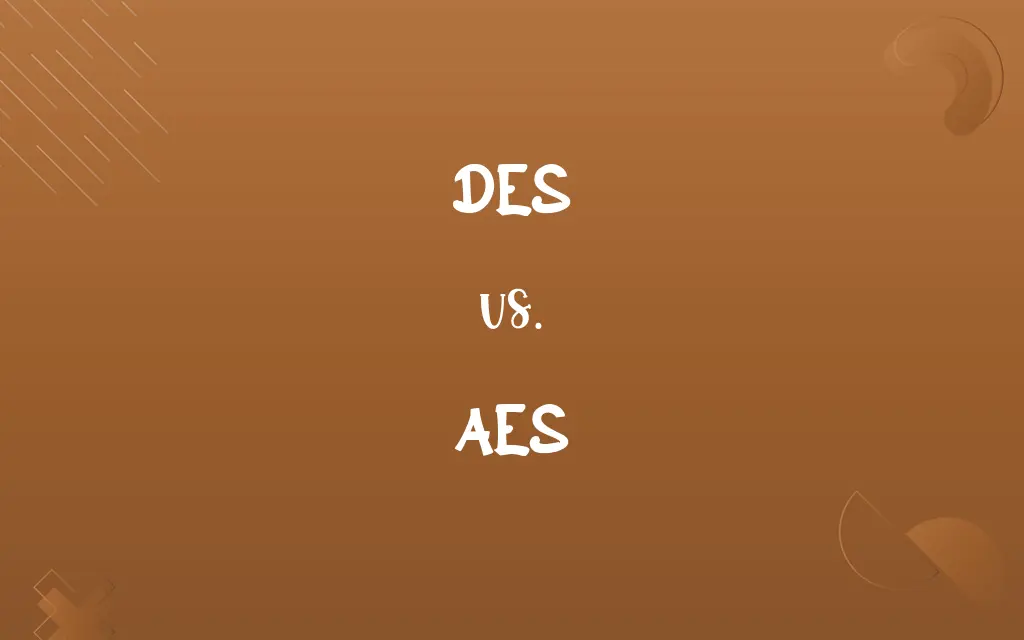DES vs. AES: Know the Difference

By Shumaila Saeed || Published on February 16, 2024
DES (Data Encryption Standard) is an older symmetric-key algorithm using a 56-bit key, while AES (Advanced Encryption Standard) is a newer, more secure standard with key sizes of 128, 192, or 256 bits.

Key Differences
DES (Data Encryption Standard) was established in the 1970s as a widely used encryption method, utilizing a symmetric-key algorithm with a 56-bit key. It encrypts data in 64-bit blocks, leading to vulnerabilities due to the limited key size. AES (Advanced Encryption Standard), adopted in the early 2000s, uses symmetric key encryption as well, but it offers key sizes of 128, 192, or 256 bits, providing stronger security. AES encrypts data in 128-bit blocks, making it more resistant to brute-force attacks.
Shumaila Saeed
Feb 16, 2024
The encryption process in DES involves 16 rounds of permutation and substitution, a structure known as the Feistel network. This was considered secure in its time, but the limited key size eventually led to its vulnerability. AES, in contrast, does not use the Feistel network but employs a more complex process of substitutions, permutations, and mixing across multiple rounds (10, 12, or 14 rounds, depending on the key size). This makes AES more secure against modern cryptographic attacks.
Shumaila Saeed
Feb 16, 2024
DES was primarily designed to be implemented in hardware and was one of the first widely accepted encryption standards, but its shorter key length became a security risk with the advent of powerful computers. AES was designed to be both efficient in hardware and software, offering flexibility and increased security. It is now the standard used globally for encrypting sensitive data.
Shumaila Saeed
Feb 16, 2024
In terms of performance, DES is generally slower and less efficient when compared to modern encryption standards due to its older design and structure. It has largely been replaced in most applications due to its vulnerabilities. AES offers better performance and security, capable of handling large volumes of data efficiently, which is why it's favored in both government and private sector encryption applications.
Shumaila Saeed
Feb 16, 2024
DES has been superseded by Triple DES (3DES) for applications requiring stronger encryption within the DES framework, using three 56-bit keys in succession for increased security. However, AES still surpasses 3DES in terms of security and efficiency, as it was specifically designed to address the shortcomings of DES and meets the requirements of modern encryption standards.
Shumaila Saeed
Feb 16, 2024
ADVERTISEMENT
Comparison Chart
Security Level
Less secure, vulnerable to brute-force
Highly secure, resistant to attacks
Shumaila Saeed
Feb 16, 2024
ADVERTISEMENT
DES and AES Definitions
DES
DES is a symmetric-key encryption algorithm with a 56-bit key.
“DES was once the standard for encrypting sensitive data.”
Shumaila Saeed
Jan 24, 2024
AES
AES allows for key sizes of 128, 192, or 256 bits.
“AES’s flexibility in key sizes enhances its security.”
Shumaila Saeed
Jan 24, 2024
DES
DES was the first widely accepted symmetric encryption standard.
“DES set the groundwork for modern encryption methods.”
Shumaila Saeed
Jan 24, 2024
AES
AES encrypts data in 128-bit blocks.
“AES’s 128-bit block size makes it resilient against attacks.”
Shumaila Saeed
Jan 24, 2024
DES
DES encrypts data in 64-bit blocks.
“DES operates by dividing text into 64-bit blocks before encryption.”
Shumaila Saeed
Jan 24, 2024
ADVERTISEMENT
AES
AES is efficient in both hardware and software.
“The design of AES allows for fast data encryption and decryption.”
Shumaila Saeed
Jan 24, 2024
DES
DES uses a Feistel network structure.
“DES’s Feistel network involves 16 rounds of permutations and substitutions.”
Shumaila Saeed
Jan 24, 2024
AES
AES is a modern symmetric-key encryption algorithm.
“AES is used globally for securing confidential data.”
Shumaila Saeed
Jan 24, 2024
DES
DES has been largely replaced due to security limitations.
“Due to its vulnerability, DES has been superseded by more secure algorithms like AES.”
Shumaila Saeed
Jan 24, 2024
AES
AES is the preferred standard for government data encryption.
“AES is endorsed by many governments for securing classified information.”
Shumaila Saeed
Jan 24, 2024
DES
A potent estrogen used in medicine and in feed for livestock and poultry
Shumaila Saeed
Jan 24, 2024
DES
Synthetic nonsteroid with the properties of estrogen; formerly used to treat menstrual problems but was found to be associated with vaginal cancers in the daughters of women so treated during pregnancy
Shumaila Saeed
Jan 24, 2024
Repeatedly Asked Queries
What is DES?
DES is a symmetric-key encryption algorithm with a 56-bit key.
Shumaila Saeed
Feb 16, 2024
Can DES still be used for encryption?
While possible, DES is not recommended due to its security vulnerabilities.
Shumaila Saeed
Feb 16, 2024
What type of encryption is DES?
DES is a symmetric-key encryption algorithm.
Shumaila Saeed
Feb 16, 2024
Does AES replace DES?
Yes, AES is considered a replacement for DES due to its enhanced security.
Shumaila Saeed
Feb 16, 2024
What makes AES more secure than DES?
AES's larger key sizes and complex encryption process provide stronger security.
Shumaila Saeed
Feb 16, 2024
What is AES?
AES is an advanced symmetric-key encryption standard with key sizes of 128, 192, or 256 bits.
Shumaila Saeed
Feb 16, 2024
Why is DES considered less secure today?
DES's 56-bit key size makes it vulnerable to brute-force attacks.
Shumaila Saeed
Feb 16, 2024
How does key size affect encryption?
Larger key sizes increase the security by making the encryption harder to break.
Shumaila Saeed
Feb 16, 2024
Is AES encryption complex?
AES is complex in its operation but designed for efficient implementation.
Shumaila Saeed
Feb 16, 2024
Does AES have any known vulnerabilities?
As of now, there are no practical vulnerabilities known for AES.
Shumaila Saeed
Feb 16, 2024
Who uses AES for encryption?
AES is used by various organizations, including governments, for secure data encryption.
Shumaila Saeed
Feb 16, 2024
Is AES widely used in industry?
Yes, AES is globally used in both private and government sectors for encryption.
Shumaila Saeed
Feb 16, 2024
Was DES ever cracked?
Yes, DES was cracked using brute-force attacks, highlighting its vulnerability.
Shumaila Saeed
Feb 16, 2024
What succeeded DES initially?
Triple DES (3DES) was initially used as a more secure alternative to DES.
Shumaila Saeed
Feb 16, 2024
Is AES suitable for encrypting large volumes of data?
Yes, AES is efficient and suitable for encrypting large volumes of data.
Shumaila Saeed
Feb 16, 2024
How is DES different from 3DES?
3DES applies the DES algorithm three times with different keys for enhanced security.
Shumaila Saeed
Feb 16, 2024
Is AES faster than DES?
Generally, AES is faster and more efficient than DES.
Shumaila Saeed
Feb 16, 2024
Why was AES developed?
AES was developed to address the security limitations of DES and meet modern encryption needs.
Shumaila Saeed
Feb 16, 2024
What industries rely on AES?
Industries like finance, healthcare, and technology rely on AES for securing data.
Shumaila Saeed
Feb 16, 2024
Share this page
Link for your blog / website
HTML
Link to share via messenger
About Author
Written by
Shumaila SaeedShumaila Saeed, an expert content creator with 6 years of experience, specializes in distilling complex topics into easily digestible comparisons, shining a light on the nuances that both inform and educate readers with clarity and accuracy.





































































